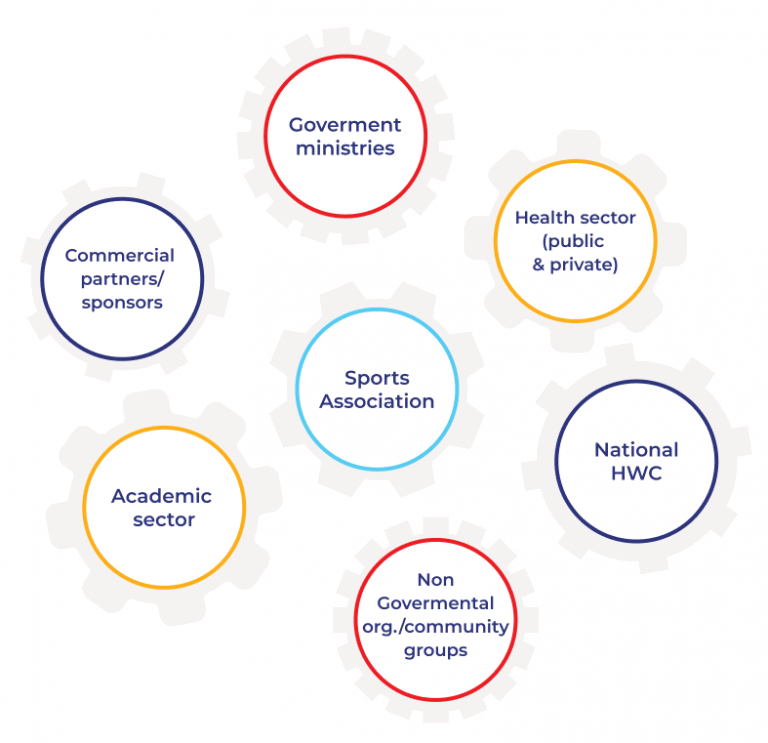


Identify partnerships and resources
- Successful implementation will require the allocation of facilities, equipment, and human and financial resources. By carefully planning this process, you will be able to determine whether your implementation plan is viable.
- External stakeholders (e.g. ministries, health sector, commercial sector, academic community) will have a mutual interest in enhancing the health of the population and may provide support for your efforts.
- Working together will reduce the demand on association resources and improve synergies and outcomes.
- Ensure that internal partners (e.g. clubs, managers, coaches, instructors, volunteers) have buy-in rights and ownership of the SCforH plan.
- Search ahead of time for external partners who share your interests and will be able to support your aims.
- Identify funding opportunities.
The implementation of the SCforH approach in a “traditional” sports association may be challenging. All stakeholders need to be convinced to support this implementation through intensive communication both before and during the process. When you have secured the support of the management and of all association departments and committees at the national level, it becomes much easier to engage the support of the entities at regional and local levels. Therefore, it is crucial to secure internal commitment and partnership first and foremost.

The modern sports organisation operates within an environment that requires much greater amounts of collaboration and cooperation. Up until recently, bodies and associations that governed sports could concentrate primarily on developing internal strategies and addressing matters that were directly related to their specific aims, activities, codes, or games. Today, we see that higher expectations are being placed on these bodies and associations, forcing them to respond to societal issues, such as health and well-being and requiring them to collaborate more often with diverse partners that range from governmental entities to health bodies.
We are breaking new ground and exploring new territories. Therefore, it is necessary to seek the support and cooperation of stakeholders with the appropriate knowledge, skills, and resources. You will be required to engage with all potential stakeholders, including members of the academic community (with expertise in health promotion); health department representatives; government institutions that are responsible for promoting healthy lifestyles within the population on the national, regional, or local levels; key players in the medical health sector, and many others.

Examples of successful external partnerships:
Finnish Schools on the Move (Finland) Fit for Life programme funding local sport clubs (Finland) Partnership with the health sector – case study (Germany) Partnership with the welfare sector – case study (Germany) Partnership between Örebro County Sport Fed and Örebro County Council (Sweden) Corporate Social Responsibility Partnership: Irish Life/GAA Healthy Clubs (Ireland)
Lessons learned from successful partnerships:
- Determine your aims and expectations clearly before you pursue a partnership.
- Search for suitable partners prudently and try to identify their ability to meet your expectations ahead of time.
- Try to identify how your association/club can support the aims of your potential partner.
- Consider the shared or complementary goals and determine whether it will be possible to achieve a win-win situation for both partners.
- Once the partners have formed a general agreement, they should develop a concrete partnership agreement together, to outline the goals, actions, and outcomes.
- Appoint a contact person within your organisation who is responsible for monitoring the partnership and ask the partner to do the same.
- Ensure that you communicate regularly with your partner and ensure that the challenges are addressed in a mutually agreeable manner.
- Agree to hold regular meetings with your partner to evaluate the process progress and the outcomes.
- Ensure that you take a collaborative approach toward public relations to promote the partnership.
- Necessary resources for SCforH development depend on the type of approach (area 1) and the types of initiatives (area 4) used.
- The first steps can be initiated without the investment of additional resources. Only the willingness and creativity of the engaged persons are needed.
- A progressive development needs higher investment of human and financial resources.
Secure internal resources:
- Identify possible human resources among the staff and/or volunteers in your association, who could carry out particular tasks in the implementation of the SCforH approach.
- Allocate a particular budget for the implementation of SCforH approach.
Secure external resources:
- Identify public and private funding opportunities, e.g. Ministries, governmental institutions, foundations.
- Seek sponsorships, e.g. in the insurance industry, sport and lifestyle industries, food companies, travel agencies, retail, the media.